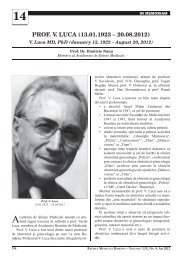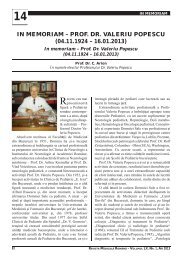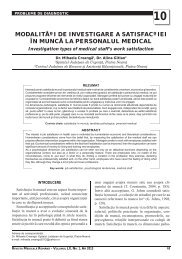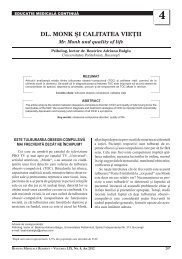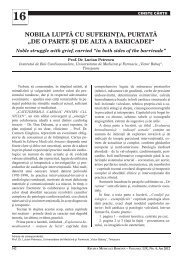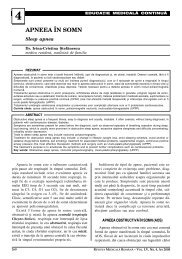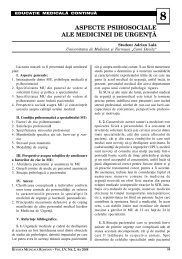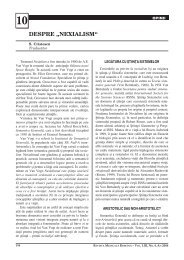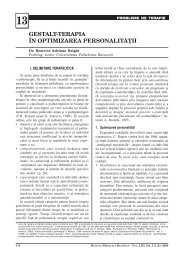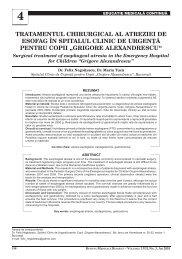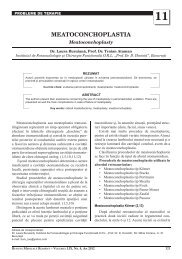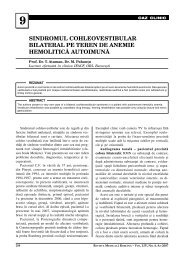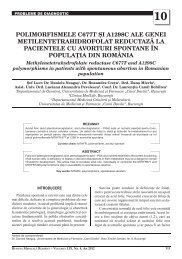You also want an ePaper? Increase the reach of your titles
YUMPU automatically turns print PDFs into web optimized ePapers that Google loves.
104<br />
anti-CCP3 creşte treptat, aceasta fi ind cea mai crescută<br />
cu un an înainte ca simptomele să se ma nifeste.<br />
Concluzie<br />
Anticorpii anti-CCP3 IgG sunt consideraţi un<br />
marker valo<strong>ro</strong>s în diagnosticul PR la debut. În plus,<br />
aceştia ar putea să identifi ce grupul de pacienţi cu<br />
PR în evoluţie. Se consideră că anticorpii anti-<br />
CCP3 IgG conferă acurateţe diagnosticului de PR.<br />
Specifi citatea înaltă, posibilitatea să ajute diag nosticul<br />
de PR la debut şi evoluţia bolii ne determină<br />
să considerăm anticorpii anti-CCP3 IgG un marker<br />
se<strong>ro</strong>logic deosebit de important în viitor.<br />
Cuvinte cheie: anticorpii antipeptide ciclice citru<br />
linate, ELISA, sensibilitatea şi specifi citatea testului,<br />
poliartrita reumatoidă la debut.<br />
Practi cal use of the Eu<strong>ro</strong>pean best<br />
informati on th<strong>ro</strong>ugh regional outcomes<br />
in diabetes<br />
S. Pruna 1 , Andreea Bealle 1 , Cristi na Purti ll 1 ,<br />
Daniela Lica<strong>ro</strong>iu 2 , Daniela Ocrain 2 ,<br />
Simona Carniciu 2 , C. Ionescu-Tirgoviste 2<br />
1 Tele<st<strong>ro</strong>ng>medica</st<strong>ro</strong>ng> Consulti ng, Bucharest, Romania<br />
2 Nati onal, Inst. of Diabetes, Nutriti on and Metabolic<br />
Diseases “N. Paulescu”, Bucharest, Romania<br />
Int<strong>ro</strong>duction<br />
The aim of this study was to implement in practice<br />
the “EU<strong>ro</strong>pean Best Information th<strong>ro</strong>ugh Regional<br />
Outcomes in Diabetes” (EUBIROD), an innovative<br />
system, based on BIRO technology,<br />
designed for systematic data collection and monitoring<br />
of diabetes complications and health outcomes<br />
at diabetes centres, regional, national and<br />
Eu<strong>ro</strong>pe level.<br />
Methods<br />
This system is based on several components,<br />
some of them optional, that automatically generates<br />
local statistical reports and safely collects aggregate<br />
data to p<strong>ro</strong>duce international reports of diabetes<br />
indicators, using the same Eu<strong>ro</strong>pean stan -<br />
dard ized data defi nitions, statistical <strong>ro</strong>utines and<br />
transmission formats. Each EUBIROD Diabetes<br />
Report, whether p<strong>ro</strong>duced by one or more centres,<br />
is by defi nition entirely comparable ac<strong>ro</strong>ss the<br />
whole centers collaboration. More specifi cally,<br />
each centre, th<strong>ro</strong>ugh using the BIRO system, can<br />
p<strong>ro</strong>duce own report independently, publish results<br />
on own website and repeat the p<strong>ro</strong>cedure whenever<br />
REVISTA MEDICALÅ ROMÂNÅ – VOLUMUL LIX, NR. 2, An 2012<br />
convenient. The Eu<strong>ro</strong>pean report is built at annual<br />
terms by collecting aggregate tables f<strong>ro</strong>m all partners.<br />
The whole p<strong>ro</strong>cess can be completed in few<br />
hours, as the analytical burden is distributed on all<br />
partners. The study sample was obtained f<strong>ro</strong>m the<br />
National Institute of Diabetes “N. Paulescu”, Ambulatory<br />
Diabetes Centre, Bucharest. We used baseline<br />
data 1801 newly diagnosed diabetes patients in<br />
2010, n = 897 (49.8%) women, and n = 904 (50.2%)<br />
men. The numbers of records, their male/female<br />
split by age bands is given as table below. Before<br />
any analysis is done, the data records are checked<br />
for quality. Any unsatisfactory data collection discovered<br />
during the checking or editing is either sent<br />
back to clinician to be revised because every single<br />
item of data is considered important or is rejected<br />
not being included in the analysis.<br />
Age<br />
Gender<br />
Male (%) Female (%)<br />
Total<br />
=80 23 (2.5) 22 (2.5) 45 (2.5)<br />
904 (50.2) 897 (49.8) 1801 (100.0)<br />
Results<br />
Our global EUBIROD statistical report (automatically<br />
generated th<strong>ro</strong>ugh BIRO system) was given as<br />
an exhaustive PDF document of 363 pages and as<br />
html pages, with tables and graphics related to various<br />
diabetes outcome indicators. The EUBIROD outcome<br />
indicators, based on data recorded (at least one measurement<br />
in 12 months), include p<strong>ro</strong>cess quality outcomes<br />
(individual level) e.g. BP, Lipids, HbA1c, BMI,<br />
Smoking, Treatment (Glucose Lowering Treatment)<br />
Management (Visit Frequency); outcome quality – intermediate<br />
outcomes, e.g. HbA1c > 9.0 % (poor cont<strong>ro</strong>l),<br />
Subjects with most recent HbA1c > 7,5 %, Subjects<br />
with most recent BP < 140/90 mmHg, Subjects<br />
with most recent BMI > 30, Rate of current smokers<br />
among diabetes patients and outcome quality – terminal<br />
outcomes e.g. Renal failure and Dialysis.<br />
Conclusions<br />
BIRO presents a novel and easy to use technology<br />
to monitoring of diabetes complications and health<br />
outcomes. In this paper we have shown the b<strong>ro</strong>ad<br />
scope of the BIRO framework regarding technology<br />
transfer and the main issues sur<strong>ro</strong>unding evaluation<br />
and implementation by real users of the BIRO software<br />
tools in diabetes care locations in Romania. The<br />
data presented are not designed or intended to be



